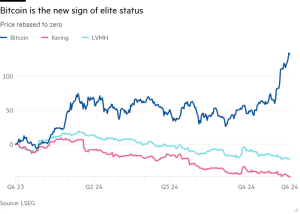Rachel Reeves loosens UK welfare spending target
Unlock the Editor’s Digest for free
Roula Khalaf, Editor of the FT, selects her favourite stories in this weekly newsletter.
UK welfare spending will be allowed to rise significantly this parliament after chancellor Rachel Reeves loosened a target on overall outlays, reducing pressure on the Labour government to make sharp cuts to benefits.
Reeves increased the ceiling the government is supposed to meet for total annual welfare spending over a parliament by 20 per cent over the five-year period to £194.5bn, according to Budget documents.
She also significantly increased the margin for overspend on the “welfare cap” from 2 per cent to 5 per cent, giving the government an extra £10bn in headroom, the documents show.
The decision was taken to avoid “having to take short-term decisions in response to unavoidable fluctuations in spending”, the government said.
Shadow work and pensions secretary Mel Stride said the extra wriggle room made the cap “meaningless” and would not give the government “any incentive to reduce spending compared to current forecasts”.
“Labour have set their new cap so high that spending can continue to spiral upwards and they still meet their rules without having to do anything,” Stride said.
The welfare cap was introduced in 2014 by then Conservative chancellor George Osborne and places a notional limit on social security spending — excluding pensions and benefits that are sensitive to the economic cycle.
Its existence has made little difference to the rise in welfare spending in recent years, but successive chancellors have retained the target, in part because it signals a political intent to control benefit costs.
Carl Emmerson, deputy director of the Institute for Fiscal Studies, said the welfare cap was a “really badly designed fiscal target” that would be better “consigned to the dustbin” than extended.
Louise Murphy of the Resolution Foundation agreed: “What happens if you breach it: nothing. They must have not felt able to scrap it or to come up with a different rule.”
The Conservatives last reset the cap in the autumn of 2021 when Rishi Sunak was chancellor, adjusting it to match Office for Budget Responsibility forecasts for welfare spending when it was clear the limit set in 2020 was unrealistic because of the pandemic.
Health-related benefits spending has since surged because of large rises in long-term sickness including mental health problems, and the OBR’s forecasts show relevant welfare spending will breach the £141bn cap this year by £8.6bn.
The fiscal watchdog now forecasts that welfare spending on incapacity and disability benefits alone will rise from £64.7bn in 2023-24 to £100bn in 2029-30, increasing from 2.4 per cent to 3 per cent of GDP.
Reeves had warned ahead of the Budget that it would contain “difficult decisions on spending, welfare, and tax”. She ultimately raised £40bn in taxes while giving big boosts to government departments’ budgets.
On welfare, the chancellor pressed ahead with some contentious Tory policies, including changes to the “work capability assessment” that will mean about 500,000 people lose out on disability support.
She also maintained the much-criticised two-child benefit cap despite pressure from poverty campaigners and her own Labour MPs. The cap means parents do not receive benefits for third or subsequent children.
In addition, Reeves continued with cuts to the winter fuel allowance she announced in July, which will remove the benefit from most pensioners.
She also announced measures to crack down on benefits fraud to save £4.3bn by 2030. But many economists are dubious about the likelihood of these savings being achieved.
“Overall, they have not made any major new welfare cuts,” said Murphy of the Resolution Foundation. This may have been because of the “political fallout from cutting winter fuel payments”, she added.

Meanwhile, the government announced it would not increase local housing allowances in line with inflation.
But overall, the Department for Work and Pensions got a 4.8 per cent real-terms increase in funding for its day-to-day budget, excluding its crackdown on fraud, reaching £9.1bn in 2025-26.
The Treasury said the chancellor had been clear that welfare spend needed to be brought under control.
An official said: “As benefit reform is accelerated from this autumn, a renewed crackdown on benefit fraud is estimated to save £9bn in welfare spend over this parliament, and the Get Britain Working package also announced at the Budget will give people out of work the support they need to move into employment and reduce their reliance on benefits.”
#Rachel #Reeves #loosens #welfare #spending #target




